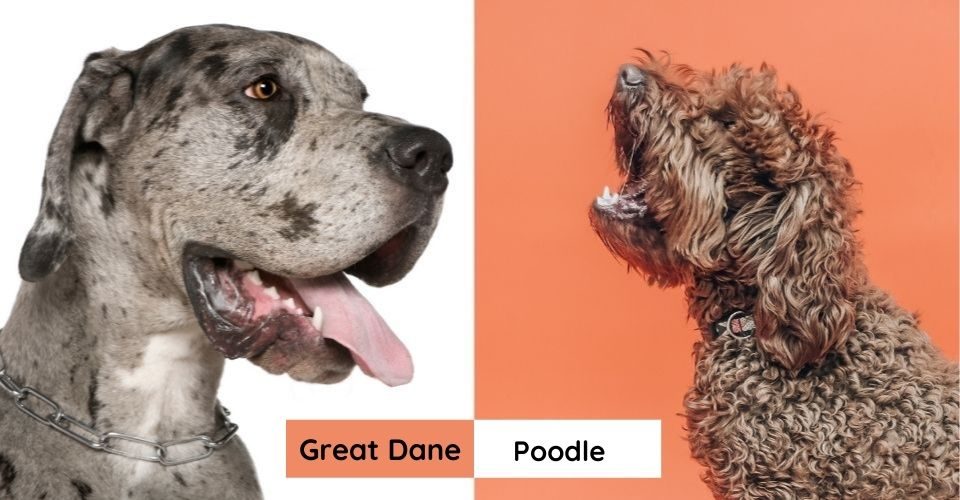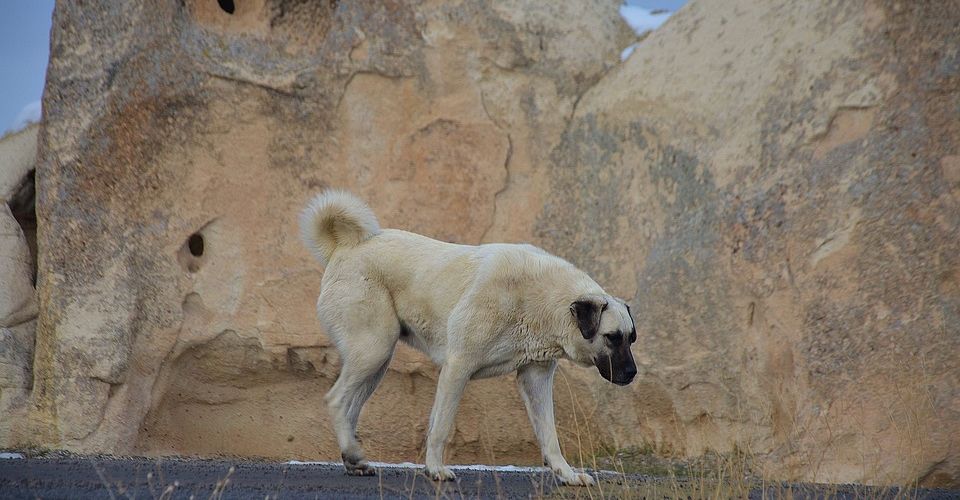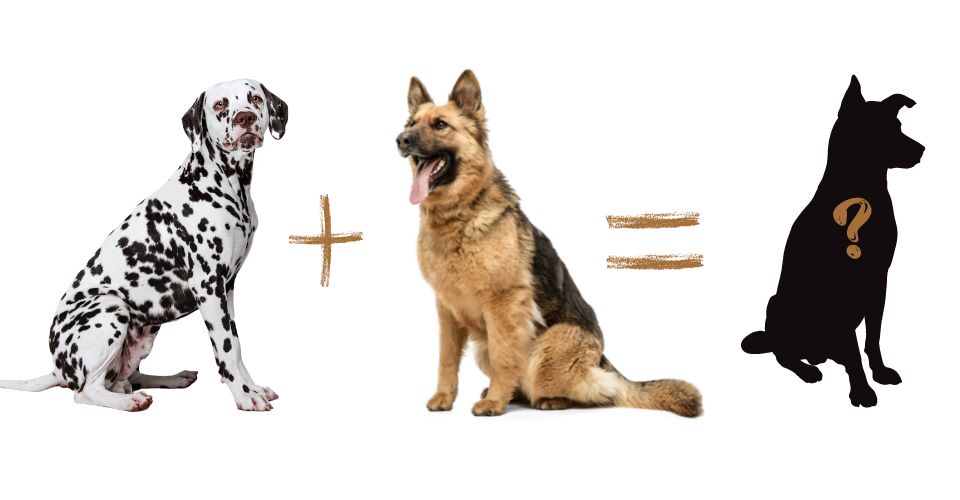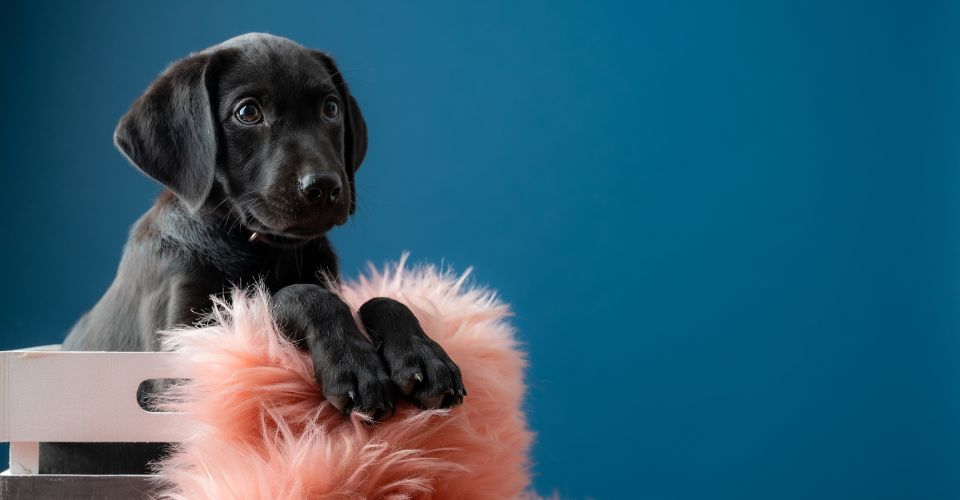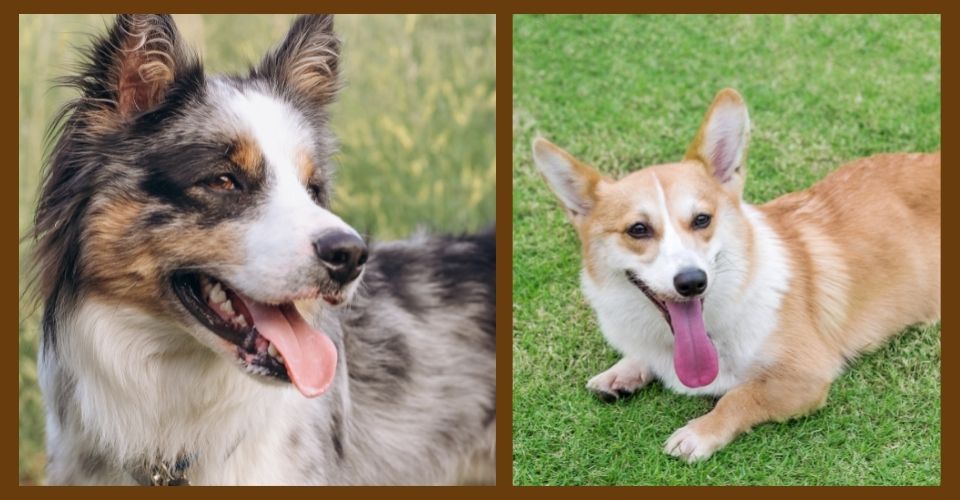The Great Dane Poodle mix, also known as Great Dandoodle, is a cross between two popular dog breeds—Great Dane and Poodle breeds. Great Dandoodles are known to have come into existence during the last century. Though they are large and heavy and can be classified as working dogs, they are too adorable for working anything other than serving as pet dogs.
They have a large and well-built muscular body like Great Danes, but at the same time, they are very delicate to look at, just like Poodles. They have a large nose and circular eyes.
Let us find out more about this amazing hybrid dog breed!
Great Dane Poodle Mix History
Like most hybrid breeds, the exact date of origin of Great Danoodle is unknown due do to the lack of research on them. So, to better understand Great Dane Poodle Mix, we will take a look at both of its parent breeds. Their know-how will make it easy to understand the offspring.
The Origin and History of the Great Dane Breed
While it is widely assumed that they come from Denmark, they are actually one of the German dog Breeds. That is why they are also called the German Mastiff. The breed was developed in the 17th century in Germany to hunt wild boars. Thereafter, they also served to protect the aristocrats of Germany.
Standing tall at 34 inches of height, Grate Dane is one of the tallest dog breeds, just after the Irish Wolf. Originally, Great Danes were classified as working dogs, but their affection and sweet nature made them a good choice to become pets as well. Today, American actor Jim Carrey has one. In the past, martial artist Bruce Lee also had a Great Dane.
Given the large size, friendly and mellow nature of Greta Danes, they are mixed with other dog breeds to create mixed breeds of desirable traits. There are many Great Dane mix-breeds, including Great Danebull, Gentle Giant, Great Shepherd, Chi-Dane-Dane, etc.
The Origin and History of the Poodle Breed
Poodles are believed to have originated the same time Great Danes did. However, unlike Great Danes which hunted the wild boars, Poodles were originally the duck hunters. The American Kennel Club (AKC) recognized Poodles in 1887. Just like humans, they are equally friendly with other animals. Poodles’ popularity is often attributed to their showy and catchy looks.
Fun Fact:
Poodle is the national dog of France.
Poodles shed very little and are considered one of the best hypoallergenic dog breeds for kids. Due to their soaring popularity and affectionate nature, they are mixed with many dog breeds to create Poodle mixes to develop hypoallergenic dog mixes. Today you can find Poodle mixes like Borderdoodle, Aussiedoodles, Irish Setterpoo, Yorkipoo, Shepadoodle, etc.
| Characteristics | Great Danoodle | Great Dane | Poodle |
| Height (inches) | 26 to 30 | 28 to 34 | 11 to 15 |
| Weight (pounds) | 90 to 170 | 90 to 200 | 45 to 70 |
| Lifespan (years) | 8 to 13 | 8 to 10 | 9 to 13 |
| Colors | Fawn, Black, Silver, and Brown | Fawn, Black, and Brown | Black, White, Brown, Silver, Sable, Apricot, and Grey |
| Eye Color | Black or Brown | Green, Light Brown, or Amber | Brown |
| Price (US$) | 500 to 1,300 | 800 to 2,000 | 700 to 1,500 |
| Age | Average Weight (pounds) |
| Birth | 2 |
| 2 Months | 25 |
| 3 Months | 35 |
| 4 Months | 50 |
| 6 Months | 70 |
| 9 Months | 80 |
| 1 Year | 90 |
Great Dane Poodle Mix Dietary Requirements
Since the Great Daneoodles are large and physically active, they need a more caloric intake than regular dogs. It means you will have to feed your dog a lot of quality food to meet his daily caloric needs.
Because your adult and the fully grown dog may reach about 170 pounds in weight, you should serve him at least 2,000 calories a day. Owing to his well-built physique and strong muscles, you should give him an adequate amount of proteins (between 20 and 30 percent) and fats in his daily diet as well. You can either feed your adult dog once a day or divide it into two or three small meals, depending on the choice of your dog.
Great Dane Poodle Mix Exercise Requirements
Great Danoodle is not a high-energy dog breed, but they do need a moderate level of exercise to stay healthy. For this, you need to make sure that your dog does his medium to intense level of workout for around an hour every day.
Failing to provide ample physical activity, your dog may suffer from obesity. Besides, you should also provide adequate space for your dog to wander and run around during free time to burn an excessive amount of energy. It is advisable that you divide the exercise into two or three sets. You can take them out for walks with you. But given their strong prey drive, you should always keep them leashed.
Since Great Danoodles are very intelligent and sharp as well, you may want to hone these traits further. Just get your dog to play some games or food puzzles that can provide him some mental stimulation.
Great Dane Poodle Mix Training
Great Dane Poodle mix has all the personality traits that make it a highly trainable dog breed. For instance, they are intelligent, smart, and above all, obedient. Despite these features, here is a list of some important points you need to keep in mind for the training sessions to be fruitful.
- Great Danoodles are quite powerful and large. But this does not mean you have to use negative reinforcement and punishment to train them; rather, positive reinforcement is the way to go.
- Owing to the high levels of intelligence, you should have a special focus on him and hold notable sessions dedicated only to mental training. You can begin with a simple session as picking up garbage since Great Danoodles are observed to be good at it.
- Due to the separation anxiety problem, you should start crate training at a young age.
- Always reward your canine for desired behavior.
- If your Danoodle is experiencing weight issues, you can cut down on treats and switch to ways to train a dog without treats—you can use belly rubs, attention, and hugs as a reward.
Great Danoodle Grooming Requirements
The brushing requirement of your Great Dane Poodle mix depends entirely on the coat he inherits. If your Dane Poo mix has inherited its coat from Dane parent, it will be shedding more, requiring more coat car. But in case it features the Poodle’s hairy coat, it will be shedding minimally, requiring only weekly brushing. Brushing your Danoodles coat regularly will keep it shiny, clean, and tangle-free.
Moreover, you will have to bathe your pup once a month, and if he gets into something muddy, you will have to bathe them using a vet-approved dog shampoo.
You should brush their teeth at least thrice a week. However, daily brushing will be better. Another way to maintain the clean look of his teeth is to always serve him quality food. You must also buy a quality toothbrush and toothpaste specially designed for dogs.
Try to trim his nails every month. This will maintain the proper length and dapper look of his paws.
Health Issues of Great Dane Poodle Mix
Great Dane Poodle mix is healthy and strong, but some health problems can affect this breed. They are:
Bloating
It occurs when the stomach fills with gas, liquid, or food. In that case, the stomach can dilate too much that it may start exerting pressure on the organs around it—cutting off the blood supply. Since dogs over 99 pounds have a 20% more risk of contracting it, Great Dane Poodle mix dogs are at a higher risk of suffering from bloating. You should visit a vet as soon as possible and avoid any treatment at home.
The indications of bloating include:
- Restive behavior
- Nausea
- Excessive drooling
Dilated Cardiomyopathy (DCM)
It is a disease in which the coronary arteries in dogs’ hearts either block or narrow down, making it harder to pump blood. It may be inherited or a result of an infection. If left untreated, it can lead to death. On average, a dog has about one to three years to live after contracting the disease.
The signs pointing towards DCM are:
- Weakness and fatigue
- Difficulty breathing
- Coughing
- Fainting
Corneal Dystrophy
It is a disease that hits dogs’ eyes in which the cornea becomes hazy. It can cause poor vision, and in extreme cases, blindness. In that case, only surgical replacement of the cornea can restore vision. The disease is limited to the eye, but it can be a cause of serious annoyance to your dog, which can lead to behavioral changes and excessive barking due to a lack of proper vision.
You must get your dog to a vet if you observe the following symptoms in him:
- Grey color appears in the cornea
- Excessively wet or dry eyes
- Erosion of cornea
- Sensitivity to light
Epilepsy
It is a common disease in dogs that impacts their brain and can cause normal to severe seizures. There can be various causes of the disease, such as a stroke, tumor, or infection. Though it is rarely fatal, it can affect your dog’s life and well-being negatively. The treatments available are therapies and medications.
Following are the signs that your dog may have epilepsy:
- Sudden unconsciousness
- Sudden falling on the floor or the loss of balance
- Excessive drooling
- Unusual Behavior
Hypothyroidism
It is a condition in which the thyroid gland fails to function properly, thus depriving the body of enough thyroid hormone it produces. Such deficiency can cause different processes in the body to slow down. Most importantly, hypothyroidism affects the process of metabolism in dogs. Any disease or infection related to the thyroid gland can lead to this condition. In extreme cases, it can be fatal.
Therefore, you should consult your vet immediately if you notice the following signs in your dog:
- Weight gain
- Hair loss
- Lethargy
- Skin color changes
Myotonia
In this disease, dogs become unable to move the affected muscle. It can impact the life of your dog as it can render him unable to move at all.
Its symptoms are:
- Weakness
- Unable to move joints
- Inability to move muscles properly
- Unable to exercise correctly
Great Dane Poodle Mix Temperament and Personality
The Great Dane Poodle mix inherits some of the best traits common in both parent breeds. However, they are famous for their unique personality and temperament.
For instance, they are polite; they do not bark excessively like most dogs do when they are in an uncomfortable position or when they perceive a threat. In the same vein, the breed is very modest—Great Danoodles do not just jump at and start licking the people they perceive as friendly. Instead, they build a friendship with time. Moreover, they are obedient, affectionate, and intelligent dogs, just like their parent breeds. These traits have also made them good guard dogs.
Having said this, note that these dogs suffer from separation anxiety, and their barks are quite loud.
Why You Should Have a Great Dane Poodle Mix Breed?
There are a plethora of reasons why you should keep a Great Dane Poodle mix at your home!
Some of them are:
Great Dane Poodle Mix Is a Good Family Dog
The breed inherits the best family-friendly traits from its parent breeds—both parents are affectionate, fun-loving, loyal, and obedient. All of these characteristics make them a great choice for anyone to keep at home. Furthermore, Great Dandoodles are extremely polite and modest. They do not start barking or passing smiles immediately to anyone they meet; rather, they take their time and establish a bond gradually.
Great Danoodle Is a Responsible Watchdog
Because of their intelligence and smartness, they start recognizing people around them very early. Hence, it is easy for them to differentiate between friends and foes. With the former, they are affectionate, but they perceive the latter as a threat. Due to their long-lasting energy stock, they are often awake at night, guarding their owner’s abode and its inhabitants.
They tend to simply bark at intruders to warn them and alert their owners.
Great Dane Poodle Mix Is Easy to Train
Thanks to the intelligence they inherit from both of their parent breeds—especially Poodle, which is listed as one of the smartest dog breeds—they are quite smart and readily understand the given training commands. Coupled with the obedience that they have, they are very easy to train. If you want a dog that does not require a lot of hard work for training, the Great Dane Poodle mix breed is for you.
The Great Dane Poodle Mix Does Not Shed Much
Great Danoodle are known to be moderate shedders. They inherit the characteristic Poodle coat and thus produce very few allergens. So while they are not one of the dog breeds that don’t shed, they won’t be shedding hair all over your house. With proper care, even people with allergies can keep them.
Why You Should Not Have a Great Dane Poodle Mix Breed?
Some of the reasons that may make you hesitate to get this hybrid breed is given below.
Great Danoodles are Susceptible to Separation Anxiety
The breed suffers from separation anxiety. Great Danoodle simply does not want the people around them to leave or abandon them for even a little amount of time. When separation anxiety hits, your dog may have behavioral changes and maybe seen barking at nothing as if he is going through some kind of trauma. Inculcating the training sessions like crate training may help your dog deal with anxiety. Additionally, keep him in the company of lots of interactive toys—even they are in the crate. That will keep them busy and occupied.
Great Dane Poodle Mix Has Hunting Tendencies
Since both Great Danes and Poodles were originally bred for hunting, the Great Dane Poodle mix has a strong prey drive. Your dog might be easily distracted to follow the smaller and weaker animals as if he is going to hunt them down; however, he might not necessarily do so and come back after only sniffing at them. But since the risk of your dog hurting any other animal is there, you should never leave them unsupervised with other small pets.
The Positives
The Negatives

